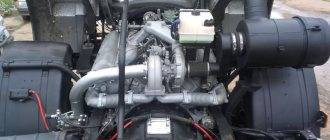Home Brands Mercedes-Benz Mercedes-Benz Vito 1
Mercedes-Benz Vito W638 is the first generation of the famous German commercial vehicle model from the automaker Daimler AG. The car was replaced by the no less famous Mercedes-Benz MB100. The presentation of the new product took place in 1995, at the end of the same year the first copies began to roll off the assembly line. It was produced in Italy, the city of Victoria, to which the name of the model is dedicated. In 1999, the car underwent a serious restyling, which affected both the appearance of the minibus and its technical part. The last copy rolled off the assembly line in 2003, and was replaced by the second generation Mercedes Vito in the W639 body.
The development of the van began already in 1989, and was supervised by Michael Mauer. The final project, which was shown in Geneva, was patented by the German automaker in 1993.
Vito appearance
The appearance corresponds to the style of the Mercedes company at that time; it incorporated all the shapes and lines familiar to cars of this brand. At first glance, the van looks as assembled and stable as possible on the road.
The front part looks brutal and assertive. The Vito has a short hood positioned at a large negative angle. Closer to the windshield there are two small slot-shaped air intakes. For this class of car, the windshield itself is also very crowded. The front optics of the Mercedes-Benz Vito have a rectangular shape, and in the area of the turn signal indicators they are rounded. The false radiator grille between the headlights is located in the same rectangle, and a large emblem of the German company is integrated in its very center.
There are two main parts in the front bumper: the upper one is protruding and the lower one is concave. In the case of the first, engineers identified a place for attaching the license plate and two small air intakes. The concave part has one large air intake and two niches in the corners for mounting fog lights.
Once assembled, the car looks good in profile. There are light stampings, extended wheel arches and a large glass area, if we are talking about a minibus, but if it is a cargo van, then the glass is replaced with metal false panels.
The restyled version of the Vito W638 is distinguished by a turn signal on the front wing without the characteristic yellow color. Closer to the threshold there is a narrow molding. Anodized roof rails are visible on the roof, and in the re-staling version, black door handles began to be painted in body color.
The rear of the car looks weighty. The taillights also have a rectangular shape, but they are oriented vertically. The small bumper has extensions in the side parts, and a small company emblem is located in the center of the steel sheet. Below the lights in the center of the trunk lid there is a small stamping for the license plate.
Dimensions:
- length – 4660 mm;
- width – 1880 mm;
- height – 1845 mm;
- distance between axles – 3000 mm;
- ground clearance – 160 mm;
- curb weight 1721 – 2071 kg.
Mercedes-Benz Vito was produced in different modifications, the following were considered basic:
- Mixto - had both two rows of seats and a cargo compartment;
- Transporter - accommodated up to 8 people, and had three rows of seats;
- Kastenwagen - a cargo van with one row of seats.
Driving and performance
The front-wheel drive model is offered with the 1.6-liter, the most available variant. This car is well suited for delivery work in the city. Rear-wheel drive and all-wheel drive models are equipped with a solid 2.2-liter unit, more power for higher mileage and payload.
1.6-liter CDI engine with 90 hp. and 111 CDI with 114 hp. models are the same, identical to those installed on the Renault Trafic. Although, Mercedes is keen to emphasize that a number of changes have been made, including a new engine control unit (ECU), which has changed many of the properties of the engine.
This four-cylinder common rail turbodiesel is a great engine for the affordable end of the van range. On the downside, you will have to put up with increased operating noise levels at speeds above 2,000. If there had been a rhombus on the false radiator grille instead of a three-pointed star, this would have been forgivable, but in our case... no.
Whatever the noise issue, for carriers who use their vehicle primarily in the city, the low power and excellent economy of the 1.6 FWD model will be quite sufficient.
Models with the 2.1-liter engine, meanwhile, are much closer to what we've come to expect from Mercedes-Benz vans. 114 CDI (136 hp), 116 CDI (163 hp) and 119 BlueTEC (190 hp). These versions are quieter, more powerful, more productive.
The engine type is again four-cylinder and equipped with a common rail system. It has two turbines mounted on it (already a significant minus in terms of reliability). This is, in fact, the same engine widely used in the MB passenger line, but modified for use for cargo purposes, high-torque low end and high-quality cruising mode.
A rear-wheel drive van allows the vehicle to feel much better on the road, accelerating smoother, cornering better and having better traction on slippery surfaces. RWD also feels better around town, and the six-speed transmission seems to operate more smoothly with this type of drive.
See also: Why are diesel engines more economical than gasoline engines?
But even with all these advantages of the rear-wheel drive layout, carriers are unlikely to often give preference to it. Firstly, it is more expensive. Secondly, to really feel the benefits and understand what excellent characteristics Mercedes has put into a rear-wheel drive car, the car must be used with a maximum load or with a trailer (trailer weight up to 2,500 tons for models with an automatic transmission).
The optional 7G-TRONIC automatic transmission also comes from Mercedes passenger cars, proof? It's how smoothly it works in automatic mode. This is by far one of the best transmissions you can get in a van for the money.
In outline. The Vito is quiet and comfortable, built as you'd expect from Mercedes-Benz. The downside is that the well-weighted electromechanical steering lacks the sense of road feedback that you get in vans from other manufacturers. You'll have to get used to the classic Mercedes foot-operated handbrake (the handbrake is activated by pressing the small pedal on the left).
Pros:
In our opinion, Mercedes performed at the highest level in this regard. However, it is worth clarifying that we are skeptical about the option of an engine with turbines.
Salon
The car was equipped with the most comfortable interior, which differed significantly from the interiors of commercial vehicles from other manufacturers. There was a pleasant “Mercedes” design, high-quality finishing materials, highly professional assembly of parts and much more.
The driver's seat has optimal filling and pronounced support. The same can be said about the front passenger seat. There is a wide range of adjustments in different ranges. Both the driver and front passenger have individual armrests. It is quite comfortable in other rows of the first generation Vito. There are also air ducts and a large supply of free space.
In front of the driver is a powerful 4-spoke steering wheel, followed by a dashboard that was classic for Mercedes at that time with yellow arrows and a speedometer in the very center.
At the top of the center console there are air ducts, and below it is the climate control unit. Even lower is the audio system and control buttons for various parts of the car, and this common slightly protruding block ends with the gearshift knob. Below there is another large block, represented by several niches. The central tunnel is completely absent, and the handbrake is located on the left under the steering wheel.
Technical characteristics of Mercedes Vito W638
The car was equipped with a huge palette of power units. Among gasoline engines, three engines were available:
- The first had a displacement of 2.0 liters and developed 129 hp. and 186 Nm of torque. It is worth noting that this was an in-line “four”.
- The next engine was also a 4-cylinder naturally aspirated one, but with a displacement of 2.3 liters. Its maximum power was 143 hp and torque 215 Nm.
- The V-shaped one, which had a working volume of 2.8 liters, was considered the most powerful. Its power was 174 hp and torque 237 Nm.
With this engine, Vito will overcome the 100 km/h mark in 12.7 seconds, and the top speed will be 184 km/h. Fuel consumption in the combined cycle should not exceed 14.7 liters.
Diesel engines, which are available in five units, are more economical. Among them there are both turbocharged and naturally aspirated modifications. The two engines have a displacement of 2.3 liters and their power is 79 and 89 hp. respectively. Three more engines produce from 82 to 122 hp. and 152 – 300 Nm of torque.
Fuel consumption in the combined cycle on diesel versions is 8-9 liters.
All engines are paired with both a 5-speed manual and a 4-speed automatic.
The Mercedes-Benz Vito W638 has a fully independent suspension, represented by MacPherson struts at the front, and at the rear it is based on trailing arms with anti-roll bar. The rack-and-pinion steering system is power-assisted, and the brakes are fully ventilated disc brakes at the front.
Fuel consumption and operating costs of the Mercedes-Benz Vito
One of the main reasons for the Vito's return to front-wheel drive configuration for this generation is cost. The mid-size Mercedes van has always been more premium than its competitors (read more expensive) and the front-wheel drive model tried to reduce the cost of the car as much as possible.
Just as the purchase price is important, so too is the running cost of a van, and Mercedes has never been behind in this area. Surprisingly, the most economical was the Vito with the second most powerful engine, one of the most powerful trim levels of the model. The 163 PS 116 CDI equipped with the BlueEFFICIENCY package can achieve a combined return cycle consumption of 4.74 l/100 km, placing it among the most economical panel vans on the market.
See also: Everything you need to know about the Volkswagen scandal
The BlueEfficiency package includes a start-stop system, low rolling resistance tires, and aerodynamic panels on the underbody of the van. The package is only available on the rear-wheel drive model and comes standard with the most powerful 190 PS engine, which is the other eco-star of the range due to its full Euro6 compliance.
Reference Information. The CDI 119 uses the SCR (Selective Catalytic Reduction) exhaust system, which is beginning to be installed on commercial vehicles to meet the latest vehicle emission standards. SCR, the selective catalytic reduction system, allows even highly loaded engines to be effectively cooled. Treatment with AdBlue (a mixture of urea and water) makes it possible to emit exhaust gases containing a minimum of nitrogen oxides. When Euro6 regulations become mandatory, all vans in the range will use the same system.
Service intervals on the Vito extend up to 40,000 km (25,000 miles) or two years. The exact time when service may be required is calculated on an individual basis by the on-board ASSYST computer, which takes into account a number of factors to provide an accurate estimate.
See also: All information about the new family of trucks, Ural Next [Technical characteristics, photos]
Maintenance and repair costs fell by 6.4% compared to the old Vito, and the Mercedes van's fully galvanized body allowed the manufacturer to offer a 12-year anti-corrosion warranty.
Typical faults
The main troubles occur on the car body, since it has poor corrosion resistance.
In 2000, the company conducted a massive recall of models for service work. The problem was a faulty brake booster. The gearbox and motor usually worked flawlessly, but the gearbox also has a weak point, which is represented by a simple cable. It can break and cause a lot of trouble at the most inopportune time. Today, on most Mercedes-Benz Vitos, the electrics “fail,” which affects the failure of the starter, generator, central electric lock, electric windows, etc.
Price
The cost on the secondary market of the first generation is quite reasonable. You can find copies that can be purchased from 150,000 rubles, but they will be in poor condition. The “live” version costs at least 250,000 rubles.
Despite the high cost of maintenance and a serious problem with corrosion, the car has proven itself well and still performs its tasks efficiently, and the new generation is used both as transfers for high-ranking people and for transporting various cargoes. The success of the model can be judged by the fact that the Mercedes Vito W638 is available in the garages of various government and law enforcement agencies.
Reliability and safety of the 2015 Mercedes-Benz Vito
Mercedes has never been shy about spending money on safety. Both the S-Class and the Vito, each in its class, will actually be standard cars for safety.
Driver and passenger airbags are standard on all models, while the Tourer minibus version can be equipped with up to eight airbags.
Also on Mercedes there are systems that do the maximum to ensure that the airbags never work:
Adaptive ESP system (directional stability serves to stabilize movement depending on the weight of the truck and its load), which, by the way, includes ABS;
Traction control system ASR;
EBD brake force distribution system;
Auxiliary emergency braking system BAS (Brake Assist System);
LAC (Load Adaptive Control), vehicle weight control system;
EUC, understeer control system.
Rear-wheel drive Vito vans are particularly well suited as towing trailers and caravans, and the TSA stability control system detects the presence of a trailer, adjusting the ESP settings accordingly to prevent the trailer from dangerously swaying while driving.
A commercial, that is, work vehicle has a nice and very useful device - a rear-view parking camera with a “coupling zoom” function. The essence of the function is to make it easier for the driver to engage the trailer hitch. At first glance, a useless new product, but in practice it has proven itself well.
Mercedes also offers Lane Keeping Assist, which warns the driver if they start to drift out of their lane without turning on the turn signals, smart lighting (adjusts the spread and intensity of the LED headlights according to the driving situation), and a distance warning system. , which starts signaling when you drive too close to the car in front. It's safe to say that the Vito in its most complete configuration is one of the safest vans in existence.
Positive traits:
It's hard to imagine a delivery van with so many security systems
Minuses:
You have to pay more for additional electronics. If something breaks, the cost of replacing the sensors will not be small.











